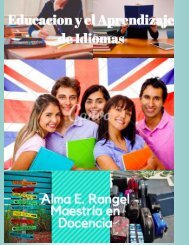Magazine
Create successful ePaper yourself
Turn your PDF publications into a flip-book with our unique Google optimized e-Paper software.
If your child is bilingual, learning<br />
additional languages later might<br />
be easier<br />
Date: October 2, 2017<br />
Source: Georgetown University Medical Center<br />
Summary:<br />
It is often claimed that people who are bilingual<br />
are better than monolinguals at learning languages.<br />
Now, the first study to examine bilingual<br />
and monolingual brains as they learn an additional<br />
language offers new evidence that supports this<br />
hypothesis, researchers say.<br />
The study, conducted at Georgetown University<br />
Medical Center and published in the journal<br />
Bilingualism: Language and Cognition, suggests<br />
that early bilingualism helps with learning<br />
languages later in life.<br />
"The difference is readily seen in language learners'<br />
brain patterns. When learning a new language,<br />
bilinguals rely more than monolinguals on the<br />
brain processes that people naturally use for their<br />
native language," says the study's senior researcher,<br />
Michael T. Ullman, PhD, professor of neuroscience<br />
at Georgetown.<br />
"We also find that bilinguals appear to learn the<br />
new language more quickly than monolinguals,"<br />
says lead author Sarah Grey, PhD, an assistant professor<br />
in the department of modern languages and<br />
literatures at Fordham University. Grey worked<br />
with Ullman and co-author Cristina Sanz, PhD, on<br />
this study for her PhD research at Georgetown.<br />
Sanz is a professor of applied linguistics at<br />
Georgetown.<br />
The 13 bilingual college students enrolled in this<br />
study grew up in the U.S. with Mandarin-speaking<br />
parents, and learned both English and Mandarin at<br />
an early age. The matched comparison group consisted<br />
of 16 monolingual college students, who<br />
spoke only English fluently.<br />
The researchers studied Mandarin-English bilinguals<br />
because both of these languages differ structurally<br />
from the new language being learned. The<br />
new language was a well-studied artificial version<br />
of a Romance language, Brocanto2, that participants<br />
learned to both speak and understand. Using<br />
an artificial language allowed the researchers<br />
to completely control the learners' exposure to<br />
the language.<br />
The two groups were trained on Brocanto2 over<br />
the course of about a week. At both earlier and<br />
later points of training, learners' brain patterns<br />
were examined with electroencephalogram (EEG)<br />
electrodes on their scalps, while they listened to<br />
Brocanto2 sentences. This captures the natural<br />
brain-wave activity as the brain processes language.<br />
They found clear bilingual/monolingual differences.<br />
By the end of the first day of training, the<br />
bilingual brains, but not the monolingual brains,<br />
showed a specific brain-wave pattern, termed the<br />
P600. P600s are commonly found when native<br />
speakers process their language. In contrast, the<br />
monolinguals only began to exhibit P600 effects<br />
much later during learning -- by the last day of<br />
training. Moreover, on the last day, the monolinguals<br />
showed an additional brain-wave pattern not<br />
14





